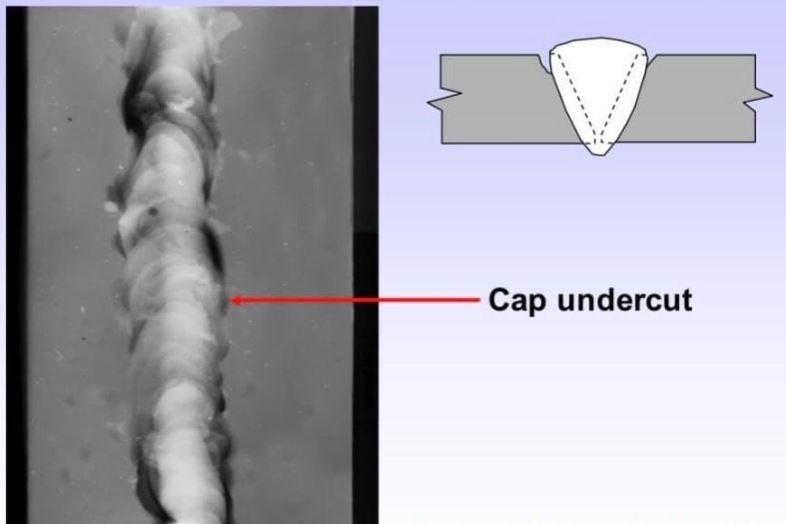Best Practices for Preventing Weld Undercut: Understanding the Fundamentals
Best Practices for Preventing Weld Undercut: Understanding the Fundamentals
Blog Article
Recognizing the Causes and Solutions for Undercut Welding in Metal Fabrication Processes
In the world of steel construction processes, the occurrence of undercut welding presents a significant challenge that requires a comprehensive understanding of its reasons and viable services. The complex interaction of numerous elements during welding operations can bring about this undesirable sensation, impacting the structural honesty and total high quality of the welded joints - Preventing weld undercut. By dissecting the source of undercut welding and exploring effective remedial steps, makers can boost the requirement of their handiwork and make certain the manufacturing of remarkable metal parts
Common Sources Of Undercut Welding
Frequently overlooked in metal manufacture, undercut welding happens because of different factors that require thorough attention and knowledge to be properly minimized. One usual root cause of undercut welding is extreme warmth input. When the heat input is too expensive, it can bring about the melting and succeeding disintegration of the base product along the edges of the weld joint, developing a groove or undercut. Furthermore, inappropriate welding strategies, such as making use of the incorrect welding angle or travel speed, can also contribute to damage development. Poor protecting gas insurance coverage is one more vital aspect that can result in undercutting. Insufficient gas protection falls short to shield the weld swimming pool effectively, causing oxidation and undercut defects. Additionally, the choice of welding criteria, such as voltage, current, and cable feed rate, plays a considerable duty in the event of undercut welding. Understanding these typical reasons is vital for applying safety nets and guaranteeing top quality welds in steel fabrication procedures.
Influence of Incorrect Welding Parameters
Imprecise welding criteria can substantially endanger the honesty and quality of bonded joints in metal manufacture procedures. The influence of incorrect welding specifications materializes in various ways, causing architectural weak points and flaws in the bonded parts. One vital facet affected by improper welding parameters is the infiltration depth of the weld. Insufficient heat input due to low welding currents or exceedingly high travel rates can cause inadequate blend between the base steels, resulting in insufficient joint penetration and damaged bonds. Alternatively, excessive warm input brought on by high welding currents or slow-moving travel speeds can bring about extreme and burn-through support, producing a weak and unsteady weld framework. In addition, inaccurate parameters such as incorrect voltage setups or wrong electrode angles can add to irregular weld grain accounts, absence of combination, and increased chances of flaws like undercutting. Thorough attention to welding criteria is critical to ensure the production of premium welds with the wanted mechanical buildings and architectural integrity.
Result of Improper Torch Angle
Improper torch angle in welding operations can substantially impact the high quality and integrity of the last weld joints in steel construction processes. Damaging is a typical welding issue where a groove develops along the weld toe, compromising the joint and compromising its structural honesty.
A lantern angle that is also steep can cause blog inadequate infiltration, incomplete fusion, and raised spatter. On the various other hand, a lantern angle that is as well shallow can lead to extreme penetration, burn-through, and distortion of the base material. Preventing weld undercut. Proper torch angle is vital for guaranteeing constant weld top quality, toughness, and appearance
To avoid undercutting and other flaws triggered by inappropriate torch angles, welders need to be trained to maintain the right torch angle throughout the welding procedure. Regular tracking and change of torch angles throughout welding can assist attain audio welds with minimal issues.
Role of Inadequate Welding Techniques

One more facet of poor welding methods is inappropriate weld prep work. Inadequate cleaning of the base metals, incorrect joint layout, or insufficient edge prep work can all contribute to damage welding. Insufficient shielding gas coverage or utilizing the incorrect kind of gas can result in insufficient combination and the formation of undercut flaws.
To deal with the duty of inadequate welding techniques in metal fabrication procedures, it is necessary to offer detailed training for welders. Proper education on welding criteria, joint preparation, and securing gas option can aid stop undercut welding and make certain high-quality welds in steel fabrication projects.
Effective Solutions for Undercut Welding
Resolving undercut welding in steel manufacture requires implementing reliable remedies to boost weld quality and architectural integrity. One of the key services to combat undercut is to change welding Click This Link parameters such as voltage, present, and take a trip speed to guarantee appropriate warmth input and blend. By fine-tuning these settings, welders can prevent extreme melting of the base steel and filler material, minimizing the likelihood of undercut formation.
Furthermore, appropriate joint preparation is critical in protecting against undercut. Making certain tidy base steel surface areas totally free of impurities and making use of the appropriate bevel angle can help advertise better weld infiltration and reduce the threat of undercut - Preventing weld undercut. Employing suitable welding techniques, such as oscillating the lantern or weaving, can additionally assist in dispersing heat equally and filling the weld joint appropriately, reducing the possibility of undercut problems
Moreover, picking the right welding consumables, consisting of electrodes and filler steels, is necessary in alleviating undercut. Utilizing materials with proper chemical make-ups and mechanical properties can read this article add to attaining audio welds with marginal undercut. Routine inspection and quality control procedures ought to additionally be carried out to identify and attend to undercut issues quickly, ensuring the overall integrity of made metal parts.

Conclusion
Finally, understanding the causes and solutions for undercut welding in steel fabrication procedures is vital for accomplishing premium welds. By resolving common causes such as wrong welding parameters, incorrect lantern angle, and poor welding methods, welders can protect against damaging and guarantee strong, durable welds. It is vital to pay interest to these factors and execute reliable services to enhance the total welding process and last product top quality.

Report this page